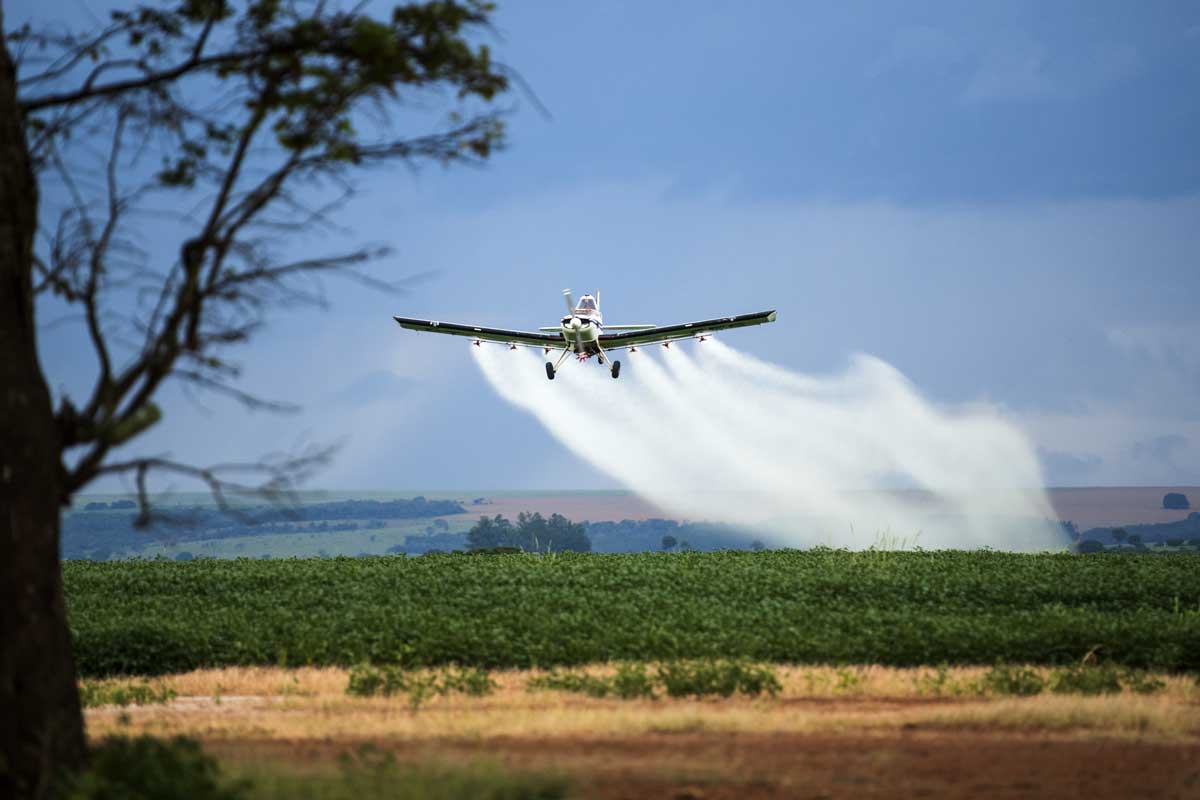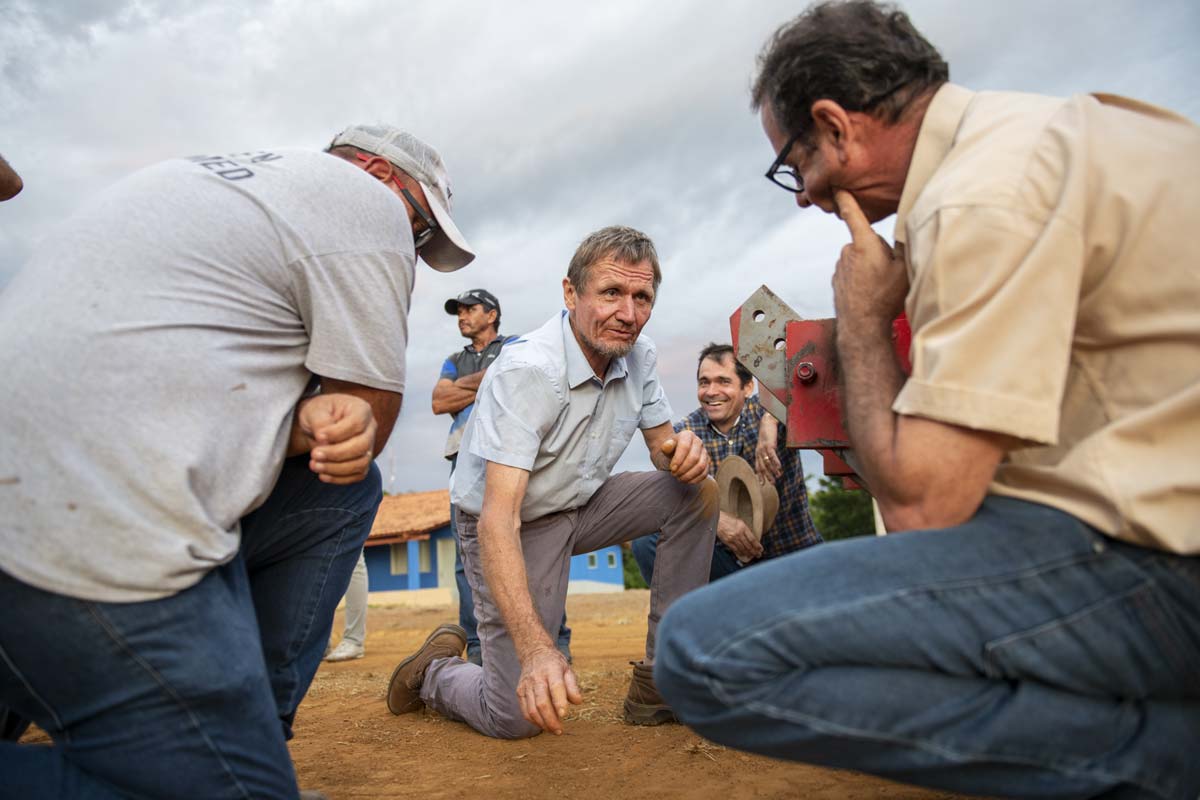Syntropy, a path out of the green desert
Mineiros. Behind the wheel of his black suburban van, Paulo Borges has to squeeze his eyes in order to focus the SUVs in front of him, vanishing in a red cloud of dust. The landowner is on the road near Mineiros in the midwest of Brazil, the granary of the South American country. Green soy fields stretch to the horizon separated by straight, reddish-brown dirt tracks. Every few kilometres, a few tall red cedars, ironwood trees and parrots remind us that this area of Brazil was once the transition forest to the Amazon. Now, the sun burns down on the flat, shadowless land. Without air conditioning, the heat in the car is unbearable. Industrial agriculture has been practiced here for three decades. That means massive use of genetically modified seeds, insecticides, fungicides, herbicides. All together is delivered in a technological package from companies such as Bayer-Monsanto, Novartis and Pioneer. The package was designed in laboratories in order to minimize natural risks such as climate variations and all sort of pests. That’s the way Borges and the men and women in the car caravan have been cultivating their soil for years and decades. That’s how Brazil became one of the global big food exporters.


A key role for forests
Unlike modern agriculture, in the syntropic model the forest plays a key role. Instead of the monotony of the Green Revolution, diversity reigns in Götsch's agroforest - regardless of whether the main production is focussed on cocoa, soy, wheat, bananas or citrus fruits. But there is still a part for human beings to play: „We are the giraffe," says Götsch with his preference for bold comparisons. The farmers regularly have to trim the rows of trees that are flanking the crops. „Trimming stimulates the growth of the plants, creates biomass which is added to the soil as a fertilizer and makes the light come in which stimulates the photosynthesis and therefore absorbs more carbon dioxide“, he explains.

From niche to large scale agriculture
Syntropy firstly attracted the attention of alternative groups and small farmers. Then, the son of a famous Brazilian businessman hired Götsch to transform his farm into a syntropical model. Fazenda da Toca in the State of Sao Paolo combined production of tropical fruit, chicken and eggs, wood and vegetables with ecological education programs for the kids of the surrounding schools. The project finally stopped due to personal problems, but made Götsch famous as the "Agroforestry Pope". He now travels around the world, from Portugal to China, as a consultant and gives workshops.
Syntropic agriculture works without fertilizer, artificial irrigation and pesticides and is 100% organic. Because of the low costs, soy farmers such as Borges, are attracted tot he model. Two years ago, Götsch started working with the group from Mineiros. What began with 40 participants has now grown to thousands, networked via whatsapp. The euphoria of the pioneering spirit can be felt at the workshop. „I am looking for new methods of cultivating, the conventional way is not sustainable from an environmental point of view, but also financially“, comments Rogerio Vian who owns 1000 hectares and cultivates corn and soy. Vania Toledo is interested not only in a more productive farm, but in a less superficial way of living: “Syntropical agriculture is a way of creating abundance, enjoying nature in its plentitude. It means being responsible and leaving a better world to our grandchildren.”
But the challenge of practising syntropic agriculture at a large scale is huge, as can be seen at Toledo´s farm Invernadinho: Not all crop associations work together, the different products such as beans, bananas, soy and citrus fruits are harvested at different moments which means more surveillance and workforce is needed. Definitely, there are no easy fitting-all-solutions compared to the technological package that comes with genetic modified crops. Each farm needs its own tailor-made combination.

"We lack consultants and suitable machines," says seminar participant Marco Janssen. Because these do not yet exist, Götsch designs his own machines. He has already found a few tinkerers able to put his sketches into practice. But during the test at Invernadinho, the large lawnmower-grass pile breaks after only a few minutes. "That's normal, we have acknowledged the error and have to try again," Götsch encourages the sceptical Janssen. Another problem is the lack of skilled consultants and workers. Götsch has trained several agronomists in his method, but by no means enough to cover the demand. Paid video tutorials on the Internet only show the basics, but do not help with every imponderability. And quick remedies are the be-all and end-all for the big farmers, because for them, a bad harvest runs into millions and can mean bankruptcy.
Anyhow, nothing deters Borges. "My family refused some years ago to live on our farm any longer. Because it smelled of chemistry, not nature," he explains. Borges has already curbed chemical fertilizers and pesticides and replaced them with compost and plant homeopathy. The syntropy, he hopes, could make glyphosate, the key herbicide in soybean cultivation, superfluous. Then grasses and weed, until now the soy farmers' most stubborn enemies, would become allies. "In ten years' time, I want to be completely free of poison," Borges said. Then, he hopes, perhaps his grandchildren will enjoy farming again.